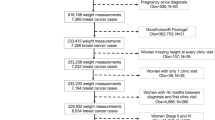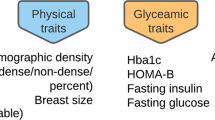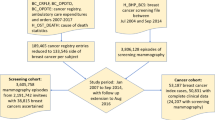Abstract
Using birth and school health records we studied how weight and height during childhood affect breast cancer risk among 3447 women born during 1924–33 at the University Hospital of Helsinki, Finland. Through linkages with the National Hospital Discharge Registry and the Cause of Death Registry we identified177 women who during 1971–1995 had been admitted to hospital with breast cancer, of whom 49 had died from the disease. Of these, 135 (76%) were aged 50 years or more at the time of diagnosis, and therefore likely to have been post-menopausal. Hazard ratios for breast cancer rose with increasing weight and length at birth, though neither trend was statistically significant. At each age, from 7 to 15 years, the girls who later developed breast cancer were on average taller and had lower body mass than the other girls. Unadjusted hazard ratios rose across the range of height (P = 0.01 at age 7 years) and fell across the range of body mass index (P = 0.009 at age 7 years). In a simultaneous analysis the hazard ratio for breast cancer was 1.27 (95% CI 0.97–1.78, P = 0.08) for every kilogram increase in birth weight and 1.21 (95% CI 1.06–1.38, P = 0.004) for every kg/m2 decrease in body mass index at 7. Our findings indicate that tallness in childhood is associated with increased risk of developing breast cancer. One possible explanation is persisting high plasma concentrations of insulin-like growth factors in talll women. In contrast, we found that being overweight in childhood reduces breast cancer risk. The increased adipose tissue-derived oestrogen levels in overweight children could induce early breast differentiation and eliminate some targets for malignant transformation. © 2001 Cancer Research Campaign http://www.bjcancer.com
Similar content being viewed by others
Article PDF
Change history
16 November 2011
This paper was modified 12 months after initial publication to switch to Creative Commons licence terms, as noted at publication
References
Berkey CS, Frazier AL, Gardner JD and Colditz G (1999) Adolescence and breast carcinoma risk. Cancer 85: 2400–2409
Braun MM, Ahlbom A, Floderus B, Brinton LA and Hoover RN (1995) Effect of twinship on incidence of cancer of the testis, breast, and other sites (Sweden). Cancer Causes Control 6: 519–524
Cerhan JR, Kushi LH, Olson JE, Rich SS, Zheng W, Folsom AR and Sellers TA (2000) Twinship and risk of postmenopausal breast cancer. J Nat Cancer Inst 92: 261–265
Cleary ML and Maihle NJ (1997) The role of body mass index in the relative risk of developing premenopausal breast cancer. Proc Soc Exp Biol Med 216: 28–43
Cold S, Hansen S, Overvad K and Rose C (1998) A woman's build and the risk of breast cancer. Eur J Cancer 34: 1163–1174
Colditz GA and Frazier AL (1995) Models of breast cancer show that risk is set by events of early life: prevention efforts must shift focus. Cancer Epidemiol Biomarkers Prev 4: 567–571
deWaard F and Trichopoulos D (1988) A unifying concept of the aetiology of breast cancer. Int J Cancer 41: 666–669
Ekbom A, Trichopoulos D, Adami HO, Hsieh CC and Lan SJ (1992) Evidence of prenatal influences on breast cancer risk. Lancet 340: 1015–1018
Ellison PT (1981) Prediction of age at menarche from annual height increments. Am J Phys Anthropol 56: 71–75
Forsen T, Eriksson JG, Tuomilehto J, Teramo K, Osmond C and Barker DJP (1997) Mother's weight in pregnancy and coronary heart disease in a cohort of Finnish men: follow up study. BMJ 315: 837–840
Forsen T, Eriksson JG, Tuomilehto J, Osmond C and Barker DJP (1999) Growth in utero and during childhood among women who developed coronary heart disease. BMJ 319: 1403–1407
Frisch RE and McArthur JW (1974) Menstrual cycles: fatness as a determinant of minimum weight for height necessary for their maintenance or onset. Science 185: 949–951
Gerhard I, Vollmar B, Runnebaum B, Klinga K, Haller U and Kubli F (1987) Weight percentile at birth: II prediction by endocrinological and sonographic measurements. Eur J Obstet Gynecol Reprod Biol 26: 313–328
Gowen LC, Avrutskaya AV, Latour AM, Koller BH and Leadon SA (1998) BRCA1 required for transcription-coupled repair of oxidative DNA damage. Science 281: 1009–1012
Grubbs CJ, Farneli DR, Hill DL and McDonough KC (1985) Chemoprevention of n-nitro-n-methylurea-induced mammary cancers by pretreatment with 17beta-estradiol and progesterone. J Natl Cancer Inst 74: 927–931
Gudas JM, Nguyen H, Li T and Cowan KH (1995) Hormone-dependent regulation of BRCA1 in human breast cancer cells. Cancer Res 55: 4561–4565
Hankinson SE, Willett WC, Colditz GA, Hunter DJ, Michaud DS, Deroo B, Rosner B and Speizer FEPollakM (1998) Circulating concentrations of insulin-like growth factor-I and risk of breast cancer. Lancet 351: 1393–1396
Hilakivi-Clarke L, Clarke R, Onojafe I, Raygada M, Cho E and Lippman ME (1997) A maternal diet high in n-6 polyunsaturated fats alters mammary gland development, puberty onset, and breast cancer risk among female rat offspring. Proc Natl Acad Sci USA 94: 9372–9377
Hilakivi-Clarke L (2000) BRCA1, estrogens and breast cancer. Cancer Res 60: 1–10
Hiney JK, Srivastava V, Nyberg CL, Ojeda SR and Dees WL (1996) Insulin-like growth factor I of peripheral origin acts centrally to accelerate the initiation of female puberty. Endocrinology 137: 3717–3728
Huang Z, Hankinson SE, Colditz GA, Stampfer MJ, Hunter DJ, Manson JE, Hennekens CH, Rosner B, Speizer FE and Willett WC (1997) Dual effects of weight and weight gain on breast cancer risk. JAMA 278: 1407–1411
Hulka BS and Stark AT (1995) Breast cancer: cause and prevention. Lancet 346: 883–887
Hunter DJ and Willett WC (1996) Nutrition and breast cancer. Cancer Causes Control 7: 56–68
Johnson MR, Abbas A and Nicolaides KH (1994) Maternal plasma levels of human chorionic gonadotrophin, oestradiol and progesterone in multifetal pregnancies before and after fetal reduction. J Endocrinol 143: 309–312
Juul A, Dalgaard P, Blum WP, Bang P, Hall K, Michaelsen KF, Muller J and Skakkebaek NE (1995) Serum levels of insulin-like growth factor (IGF) -binding protein -3 (IGFBP-3) in healthy infants, children, and adolescents: the relation in IGF-i, IGF-II, IGFBP-1, IGFBP-2, age, sex, body mass index, and pubertal maturation. J Clin Endocrinal Metab 80: 2534–2542
Juul A and Skakkebaek NE (1997) Prediction of the outcome of growth hormone provocative testing in short children my measurement of serum levels of insulin-like growth factor I and insulin-like growth binding protein 3. J Pediatr 130: 197–204
Le Marchand L, Kolonen LN, Early ME and Mi MP (1988) Body size at different periods of life and breast cancer risk. Am J Epidemiol 128: 137–152
Magnusson C, Baron J, Persson I, Wolk A, Bergstrom R, Trichopoulos D and Adami HO (1988) Body size in different periods of life and breast cancer risk in post-menopausal women. Int J Cancer 76: 29–34
Marquis ST, Rajan JV, Wynshaw-Boris A, Xu J, Yin GY, Abel KJ, Weber BC and Chodosh LA (1995) The developmental pattern of BRCA1 expression implies a role in differentiation of the breast and other tissues. Nat Genet 11: 17–26
Marshall WA and De Limongi Y (1976) Skeletal maturity and the prediction of age and menarche. Ann Hum Biol 3: 235–243
Michels KB, Trichopoulos D, Robins JM, Rosner BA, Manson JE, Hunter D, Colditz GA, Hankinson SE, Speizer FE and Willett WC (1996) Birthweight as a risk factor for breast cancer. Lancet 348: 1542–6
Nagasawa H, Yanai R, Shonodo M, Nakamura T and Tanabe Y (1974) Effect of neonatally administered estrogen and prolactin on normal and neoplastic mammary growth and serum estradiol-17 level in rats. Cancer Res 34: 2643–2646
Nilsson A, Ohlsson C, Isaksson OG, Lindahl A and Isgaard J (1994) Hormonal regulation of longitudinal bone growth. Eur J Clin Nutr 48: S150–S158
Potischman N, Swanson CA, Siiteri P and Hoover RN (1996) Reversal of relation between body mass and endogenous estrogen concentrations with menopausal status. J Natl Cancer Inst 88: 756–758
Rajan JV, Wang M, Marquis ST and Chodosh LA (1996) Brca2 is coordinately regulated with Brca1 during proliferation and differentiation in the mammary epithelial cells. Proc Natl Acad Sci USA 93: 13078–13083
Royston P (1991) Constructing time-specific reference ranges. Stat Med 10: 675–690
Sanderson M, Williams M, Malone KE, Stanford JL, Emanuel I, White E and Daling JR (1996) Perinatal factors and risk of breast cancer. Epidemiology 7: 34–37
Spillman M and Bowcock A (1996) BRCA1 and BRCA2 mRNA levels are coordinately elevated in human breast cancer cells in response to estrogen. Oncogene 13: 1639–1645
Trentham-Dietz A, Newcomb PA, Storer BE, Longnecker MP, Baron J, Greenberg ER and Willett WC (1997) Body size and risk of breast cancer. Am J Epidemiol 145: 1011–1019
Trichopoulos D (1990) Hypothesis: does breast cancer originate in utero?. Lancet 355: 939–940
Vatten LJ and Kvinnsland S (1990) Body height and risk of breast cancer. A prospective study of 23,831 Norwegian women. Br J Cancer 61: 881–885
Ziegler RG (1997) Anthropometry and breast cancer. J Nutr 127: 924S–928S
Yong LC, Brown CC, Schatzkin A and Schairer C (1996) Prospective study of relative weight and risk of breast cancer: the Breast Cancer Detection Demonstration Project follow-up study, 1979 to 1987–1989. Am J Epidemiol 143: 985–995
Author information
Authors and Affiliations
Rights and permissions
From twelve months after its original publication, this work is licensed under the Creative Commons Attribution-NonCommercial-Share Alike 3.0 Unported License. To view a copy of this license, visit http://creativecommons.org/licenses/by-nc-sa/3.0/
About this article
Cite this article
Hilakivi-Clarke, L., Forsén, T., Eriksson, J. et al. Tallness and overweight during childhood have opposing effects on breast cancer risk. Br J Cancer 85, 1680–1684 (2001). https://doi.org/10.1054/bjoc.2001.2109
Received:
Revised:
Accepted:
Published:
Issue date:
DOI: https://doi.org/10.1054/bjoc.2001.2109
Keywords
This article is cited by
-
Dose response relationship between breast cancer and somatotypes during childhood: a systematic review and meta-analysis
British Journal of Cancer (2023)
-
Associations of height, body mass index, and weight gain with breast cancer risk in carriers of a pathogenic variant in BRCA1 or BRCA2: the BRCA1 and BRCA2 Cohort Consortium
Breast Cancer Research (2023)
-
Exploring the association between birthweight and breast cancer using summary statistics from a perspective of genetic correlation, mediation, and causality
Journal of Translational Medicine (2022)
-
Birthweight, childhood body size, and timing of puberty and risks of breast cancer by menopausal status and tumor receptor subtypes
Breast Cancer Research (2022)
-
Early-life body mass index and risks of breast, endometrial, and ovarian cancers: a dose–response meta-analysis of prospective studies
British Journal of Cancer (2022)



